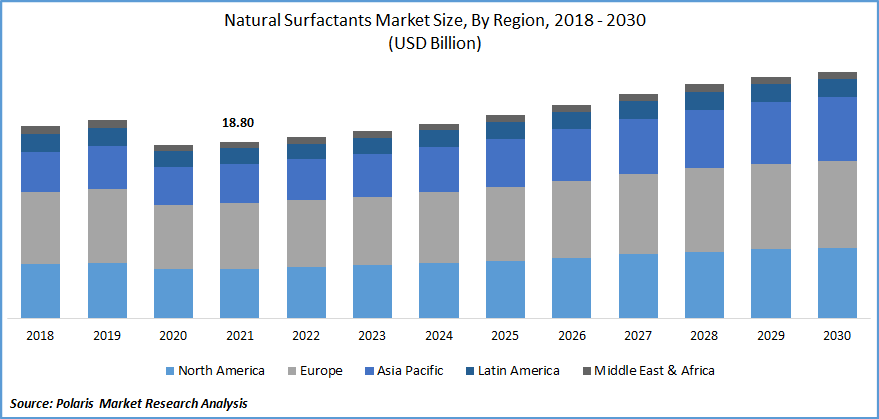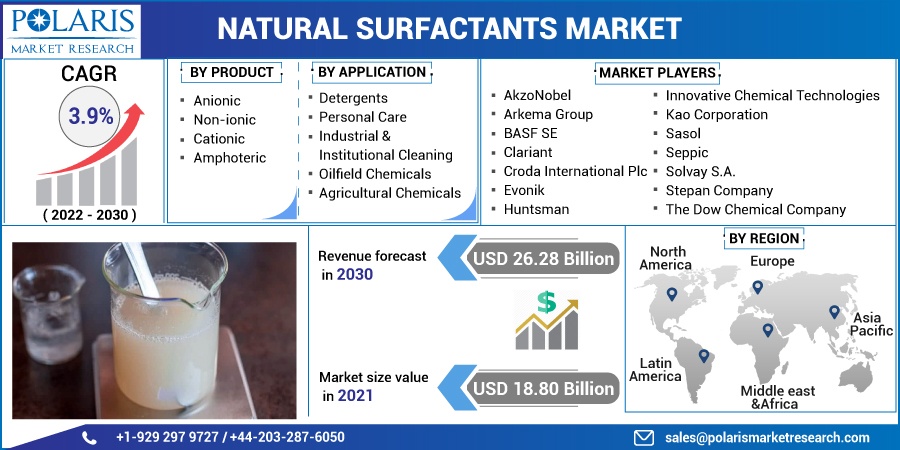
Natural Surfactants Market Share, Size, Trends, Industry Analysis Report, By Product (Anionic Natural Surfactants, Non-Ionic Natural Surfactants, Cationic Natural Surfactants, Amphoteric Natural Surfactants); By Application; By Region; Segment Forecast, 2022 - 2030
- Published Date:Jul-2022
- Pages: 115
- Format: PDF
- Report ID: PM2492
- Base Year: 2021
- Historical Data: 2018-2020
Report Outlook
The global natural surfactants market is valued at USD 18.80 billion in 2021 and is expected to grow at a CAGR of 3.9% in the forecast period. The introduction of stringent regulations on using conventional surfactants along with increasing demand for sustainable green and bio-based products is expected to generate numerous growth opportunities during the forecast period.

Know more about this report: Request for sample pages
They are synthesized from a natural raw material and are referred to as natural surfactants. They are taken directly from natural sources such as animals or plants or by using separation procedures including precipitation, extraction, and distillation. A few examples of these are fatty acid ester, fatty acid ester of sugars, and amines of amino acids.
However, the consumers’ reluctance to pay a bio-premium is anticipated to hamper the growth of the industry. The bio-based products are made from fats and oils through a process known as the oleochemical process or carbohydrates, such as molasses, in a process known as fermentation. These types are used in a variety of products such as detergents, personal care products, and institutional and commercial cleaners.
The outbreak of the COVID-19 pandemic has significantly impacted the growth of the natural surfactants market. The emergence of the deadly virus has forced many nations across the world to implement national lockdowns as a result of the unprecedented coronavirus health epidemic.
The industry has experienced disruption in the supply chain, lack of raw materials, operational challenges, transportation delays, and travel restrictions. Manufacturing activities and industrial operations have also been halted due to various government regulations across the globe. Restrictions on imports of goods to curb the spread of the virus have further contributed to restricting the market growth.
 Know more about this report: Request for sample pages
Know more about this report: Request for sample pages
Industry Dynamics
Growth Drivers
Petroleum biotechnology has advanced in recent times on account of the high global demand for renewable technologies. The petroleum industry uses a large quantity of petrochemical-based synthetic products as a mobilizing agent to improve the availability or recovery of hydrocarbons and various extraction, handling, washing, and transportation applications. Furthermore, the growing demand for renewable petroleum biotechnology is a current trend in the gas & oil industry that is also expected to drive demand.
The demand for the product has increased from industries owing to rising industrialization and urbanization. Increasing demand for detergents and personal care products and strict government regulations on the use of conventional surfactants drives the market growth. Growing investment in research and development, technological advancements, and application in diverse industries is driving the growth of the market. The economic growth in countries such as China, Japan, and India has further led to increased demand for natural products.
Report Segmentation
The market is primarily segmented based on product, application, and region.
|
By Product |
By Application |
By Region |
|
|
|
Know more about this report: Request for sample pages
Anionic natural surfactants segment to hold a major share
The surfactant market, which includes dishwashing and laundry uses, is dominated by anionic surfactants. The three most common anionic surfactants in terms of volume are alpha-olefin sulfonates (AOS), Linear alkylbenzene sulfonates (LAS), and alcohol ether sulfates (AES). Methyl ester sulfonate (MES) and Alcohol ether sulfate (AES) are the two largest sustainable anionic surfactants, which are made from coconut or palm oil.
Methyl ester sulfonate is a biodegradable substance that can be used in place of linear alkylbenzene sulfonates. Both methyl ester sulfonate and alcohol ether sulfate contribute desirable surfactant properties to detergent and personal care products. The nonionic segment accounts for a significant share due to its low toxicity and desirable properties. Cationic offers good antibacterial qualities, along with good corrosion resistance, and can also be used as a demulsified.
The detergents sector is expected to remain dominant in the revenue share
The detergents segment accounted for the largest market share of the global natural surfactants market and is also expected to grow significantly during the forecast period. There has been increasing demand for detergent and personal care products such as bubble baths, body washes, hand soaps and cleaners, grooming products, hair shampoos, and oral care products.
The demand is expected to grow owing to the rising demand for washing machines, especially in developing economies. Several vendors across the globe attempt to broaden their presence by establishing manufacturing facilities in emerging economies, which have significant sales opportunities as well. Moreover, products with natural ingredients are also common in the toiletries and cosmetics sectors. This segment includes bath & shower products, hair care, and infant care products. Oral grooming, liquid soaps, deodorants, and skincare are also experiencing growth.
The increasing utilization of detergents and growing applications such as laundry detergents, dishwasher detergents, and carpet cleaners boost the market growth. The primary role of laundry detergents is to strip out dirt from fabrics and release it into the water during washing. Also, the fabric softeners are applied to the final rinse while washing.
The overall demand for natural products is assumed to depend strongly on cosmetics and detergents, where environmental concerns are more prominent. Moreover, the importance of safety in the cosmetics industry is to encourage consumers to move toward natural products.
Europe dominated the global market in 2021
The European region dominated the global natural surfactants market in 2021. The increasing demand for oilfield detergents and chemicals is expected to drive the growth of the regional market. The growing adoption of bio-based products owing to high awareness regarding the negative effects of chemical surfactants on the environment and human health is a major factor driving the growth of the market. Additionally, the presence of a large manufacturing base for personal care products is expected to support the growth during the forecast period.
Consumers in Japan and Western Europe, who seem to be more aware of environmental issues regarding surfactant use, are the first to embrace non-petroleum-based goods. The dramatic rise in the price of crude oil in 2021–2022 piqued the interest of consumer commodity formulators and customers in oleo chemical-based surfactants. Moreover, the shifting preference of consumers towards bio-based ingredients and natural products due to the potentially hazardous effects of conventional surfactants on the skin is likely to exhibit massive growth.
Competitive Insight
Some major players operating in the global market include AkzoNobel, Arkema Group, BASF SE, Clariant, Croda International Plc, Evonik, Huntsman, Innovative Chemical Technologies, Kao Corporation, Sasol, Seppic, Solvay S.A., Stepan Company, The Dow Chemical Company, and Wheatoleo among others.
These players are expanding their presence across various geographies and entering new markets in developing regions to expand their customer base and strengthen their presence in the market. The companies are also introducing new innovative products in the market to cater to the growing consumer demands.
Recent Developments
In March 2021, Allied Carbon Solutions Co. Ltd., a leading biomass-based surfactant manufacturing company, partnered with BASF to strengthen its position in bio-based surfactants for industrial and home care products. This partnership aimed to strengthen the product development and further advancement of products such as sophorolipids.
Furthermore, In August 2020, BASF announced the launch of a naturally derived surfactant which will be manufactured from 100% natural sources under the brand name Lamesoft Balance. The surfactant is completely biodegradable and effectively stabilizes a wax-based diffusion for skin and hair cleansing formulations.
Natural Surfactants Market Report Scope
|
Report Attributes |
Details |
|
The market size value in 2021 |
USD 18.80 billion |
|
Revenue forecast in 2030 |
USD 26.28 billion |
|
CAGR |
3.9% from 2022 - 2030 |
|
Base year |
2021 |
|
Historical data |
2018 - 2020 |
|
Forecast period |
2022 - 2030 |
|
Quantitative units |
Revenue in USD billion and CAGR from 2022 to 2030 |
|
Segments covered |
By Product, By Application, By Region |
|
Regional scope |
North America, Europe, Asia Pacific, Latin America; Middle East & Africa |
|
Key companies |
AkzoNobel, Arkema Group, BASF SE, Clariant, Croda International Plc, Evonik, Huntsman, Innovative Chemical Technologies, Kao Corporation, Sasol, Seppic, Solvay S.A., Stepan Company, The Dow Chemical Company, and Wheatoleo. |
